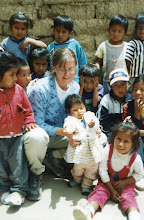When we crossed in ferry to the peninsula, we had to leave the bus and take small boats of 15-20 people to the other side. The bus was driven onto a ferry, which looked like a dock, or pierhead, or a gigantic raft. At one point in the middle of the channel the ferry bobbed up and down so much, I thought the bus wouldn't make it. Ours was the largest vehicle to cross at that time.

A week earlier two boats had collided and a couple of people drowned. The military police were out on our return crossing to make sure the boats were not over loaded and that everyone had a lifevest. The life jacket was very sketchy in my opinion and since I was the only one who knew how to put one on, I felt it but a joke (no safety talk on this boat). Though I know how to swim I put one on to show others, and to be able to help if there were an actual emergency.
Our second day we took a boat to Isla del Sol (the Island of Sun), the ride was almost two hours. When we arrived we basically went to the beach. There were soccer and volley ball games, some of us rolled up our pants and waded in the water. The campers on the beach (mostly foreigners) said the water was warm. Having worked sailboats in Maine, where water temps could fall under 60 F, I would consider this water cold!! After the soccer games some folks actually did swimm around.
What impressed me most in the boat ride and on the bus ride from the ferry to Copacabana were the proliferation of terraces, or terraced land. I had seen it before in Bolivia but not to this extent. It impressed me that so much land had been cultivated. I could only imagine the extent of the Inca Civilization. There were still working terraces that we passed by boat. The water temps in Lake Titicaca are said to remain the same year round, making it a great place to raise crops. Below is the best shot that I was able to get, but like the Grand Canyon it is hard to get a picture that truly represents what I saw.

After out time on the beach we boarded the boat again for a short cruise to another port on the island were we saw ancient ruins (stay tuned for next post for details) While we were there a reed catamaran set sail from the dock to head back to Copacanana. I hope to return some day to take a sail on that boat. The sailors also had long oars to halp get them out of port. The boats of old on Lake Titicaca were mostly made of reed. If you are in Washington DC you can see one of these reed canoes on display in the native American Museum in the main foyer.





I am loving reading about your pilgrimage to Copacabana. Thanks for taking us with you on this journey. I know where I am going next in DC-to see some reeds! ;-) I hope you make it back to sail on the boat you write of. Although I was surprised by how touristy Isla del Sol was, it was also incredibly beautiful and the Incan spirit and brilliance remain. Peace to you.
ReplyDelete